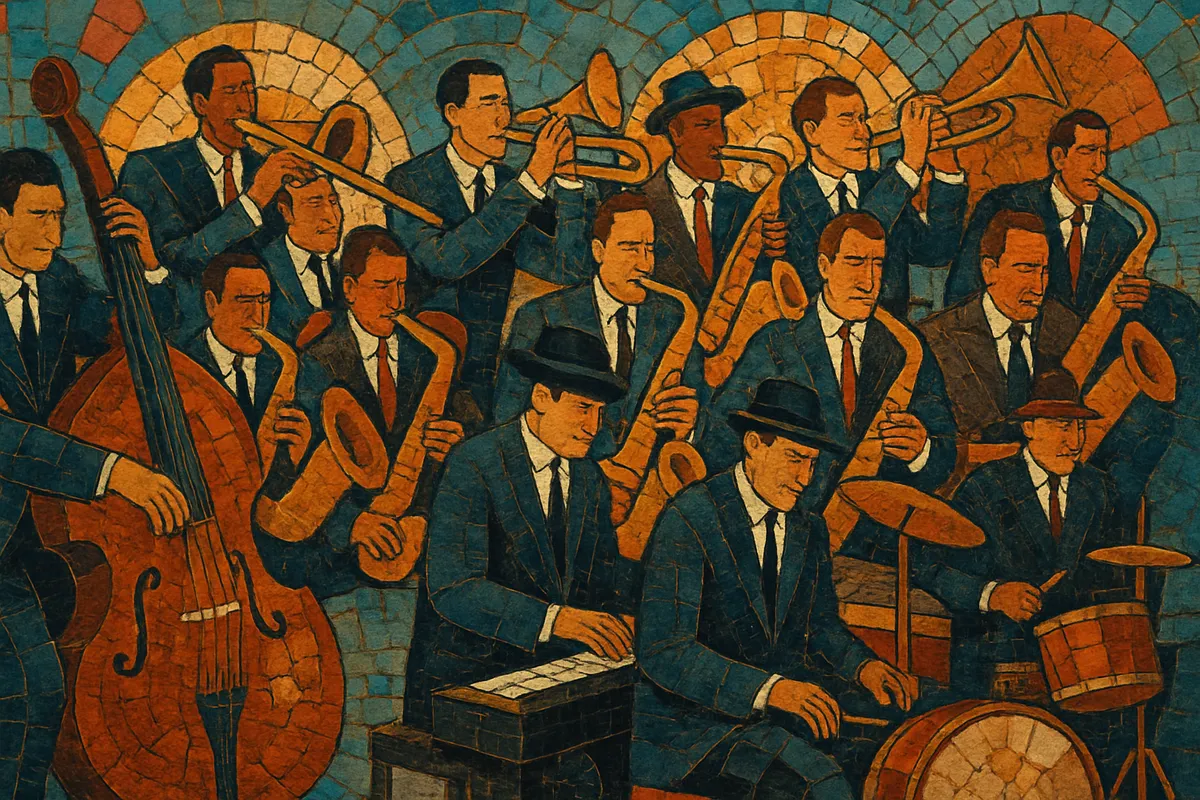Big band is a large-ensemble style of jazz and popular dance music built around brass, reed, and rhythm sections playing arranged parts.
Typical instrumentation includes five saxophones (often doubling clarinet/flute), four trombones, four trumpets, and a rhythm section of piano, guitar, upright bass, and drum set. The music emphasizes swing rhythms, call-and-response between sections, riff-based writing, and dramatic shout choruses, while leaving space for improvised solos.
Born in American ballrooms and theaters, big band became the sound of the Swing Era, providing both music for dancing and a platform for sophisticated arranging and orchestration that shaped much of 20th‑century jazz and popular music.
Big band grew from early jazz, ragtime, and dance orchestras that expanded in size to fill ballrooms and theaters. Bandleaders such as Fletcher Henderson and Paul Whiteman pushed toward larger, section-based ensembles, formal arrangements, and orchestral color, laying the groundwork for saxophone, trumpet, trombone, and rhythm sections to function as coordinated units.
The style matured into the dominant popular music of the United States. Duke Ellington and Count Basie refined contrasting approaches—Ellington with innovative orchestration and tonal color, Basie with a lean, riff-driven Kansas City swing. Bandleaders like Benny Goodman, Glenn Miller, Tommy Dorsey, Artie Shaw, Woody Herman, and Cab Calloway brought big band to radio, records, and national tours. Arrangers codified techniques such as soli passages, sectional call-and-response, backgrounds behind solos, and climactic shout choruses.
World War II economics, changing tastes, and the recording ban strained touring ensembles. Many musicians moved toward smaller, more experimental groups, fueling bebop and modern jazz. Some big bands adapted with tighter budgets or studio-focused work, while others dissolved.
Stan Kenton’s progressive jazz orchestras, Woody Herman’s Thundering Herds, and the Thad Jones/Mel Lewis Orchestra kept the idiom artistically vibrant. Latin big bands (e.g., Machito) fused Afro‑Cuban rhythms with big band orchestration, shaping Latin jazz. From the 1980s onward, institutional bands, university jazz programs, and periodic swing revivals sustained the format, while contemporary composers continue to expand big band harmony, rhythm, and timbre.
Use a standard 17–18 piece lineup: 5 saxophones (AATTB, with doubles), 4 trombones (3 tenor + 1 bass), 4 trumpets, and rhythm (piano, guitar, bass, drums). Consider optional vibes, clarinet features, or auxiliary percussion for color.
Write primarily in swinging 4/4 with a walking bass, ride-cymbal swing pattern, and comping from piano/guitar. Early styles may use two-beat feels; ballads call for brushes and sustained brass/reed pads. Typical tempos range from 100–260 BPM for dancers; balance contrast with ballads and medium-swing.
Base tunes on 12-bar blues and 32-bar AABA song forms. Employ functional jazz harmony with extended/altered chords (9ths–13ths), tritone substitutions, and secondary dominants. Modulations and interludes help shape longer arrangements.
Feature concise, idiomatic solos (sax, trumpet, trombone, sometimes rhythm) and ensure tight ensemble articulation (short vs. legato swings). Align drum set set-ups with ensemble figures; rehearse cut-offs and releases. If using a vocalist, arrange key to range, provide set-ups and tags, and integrate band fills tastefully.


